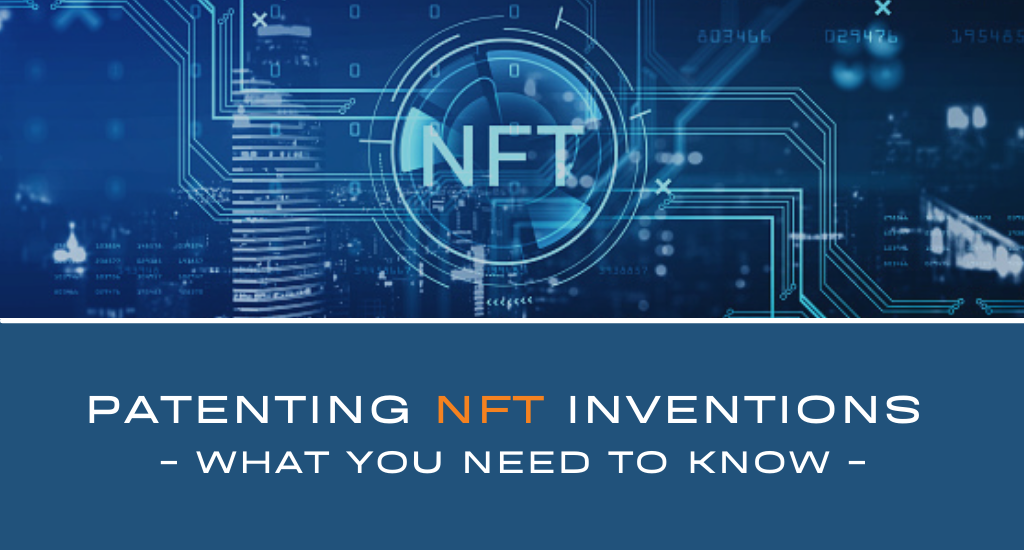- February 22, 2022
- Posted by: mbipuser
- Category: Latest article

Patenting NFT Inventions: What You Need to Know
Are you working on new NFT-related projects in the wake of the current market hype around NFTs? Like for any other technology, you should be considering whether there are any aspects of your project which may be patentable.
In this second part of our two-part series on NFT technology and patents, we will give you some tips about how to think about patenting NFT-related innovations. These tips can help you decide whether it is time to consult a patent professional or not.
In our last article, we talked about how NFTs work as well as the reasons for the current hype around NFTs. If you are not already familiar with NFTs, I would suggest starting with that article here.
As a very brief recap of NFT technology, non-fungible tokens (NFTs) are effectively data that indicates ownership. The tokens are non-fungible in the sense that one token is not necessarily interchangeable with another. NFT solutions typically record transactions involving NFTs on a blockchain, which is a digital ledger of transactions distributed among many peer computers. Smart contracts, which are computer programs encoded and stored on the blockchain, may be implemented in order to control transfers or use of NFTs.
Now that we’ve established the core technology behind modern NFT implementations, we can recognize that this core technology is already well-established. Consequently, a patentable NFT feature must provide something beyond the existing paradigm of NFTs. Specifically, US patent law requires that patentable inventions must be (among other things) new and non-obvious. Any solution that is either not new (i.e., the same innovation does not already exist) or obvious (i.e., an identical solution does not exist but would be an obvious variation of an existing solution) will not be patentable.
One reasonable question you may have about the patent requirements of new and non-obvious is whether you can patent a new use of NFTs. For example, if I come up with the first NFT of a cat video, could I patent that? The answer typically depends on whether you needed to modify the NFT technology to adapt it to cat videos or if you are just using the existing technology for a new type of video, but let’s assume for this example that the only change as compared to existing NFT features is using a new type of content (i.e., cat videos). There are two key problems with attempting to patent this use: obviousness, and subject matter eligibility.
In terms of obviousness, although our previous example featured a new use of NFTs (cat videos), this implementation is arguably obvious given that NFTs were already used for videos and this is simply a different (known) type of video. Assuming that the NFTs themselves or the techniques involving the NFTs aren’t different, it would be difficult to overcome challenges based on obviousness. Although a technological improvement does not need to be “big” to be non-obvious under US law (i.e., the improvement does not need to be some huge leap over the prior art), the above cat video example does not actually provide any improvements to the technology by simply using the existing technology on another type of content.
Subject matter eligibility is another requirement for US patents. US subject matter eligibility has its statutory roots in 35 USC 101 and being further developed through case law such as in Alice Corp. Pty. Ltd. v. CLS Bank Int’l, 573 U.S. 208 (2014). US subject matter eligibility law generally requires that patent claims directed to judicial exceptions to patentability (abstract ideas, laws of nature, and natural phenomena) integrate any such judicial exceptions into a practical application in order to be patentable. In the wake of the Alice decision in 2014, US subject matter eligibility has made patenting certain kinds of technology more challenging but not impossible.
Many computer-related innovations are argued as being directed to abstract ideas, particularly mental processes. Knowing that this is a very real possibility, US patent practitioners must draft any computer-related patent applications with subject matter eligibility in mind. A fairly typical way of demonstrating subject matter eligibility for a computer-related innovation is to demonstrate how the new features improve the functioning of a computer, for example, by improving processing speed, reducing memory usage, improving network communications involving the computer, or otherwise allowing the computer to perform functions that were not previously possible.
The challenge with our above cat video example is that the new use of the NFTs does not improve the computer in any way. This implementation merely uses existing NFT technology for a new type of content. The computer functions virtually identically to how it would when handling any other type of video content.
Having identified what is usually not considered patentable in the realm of NFTs (i.e., new purely business uses of NFTs such as using NFTs for new types of content), let’s take a deeper look at what you might be able to patent in relation to NFTs. As with any computer-related innovation, we want to focus on improvements that affect the way the computer functions. Even if your goal is a new business use (like our cat video example above), a new underlying computer improvement that happens to enable the new business use may still be patentable.
To this end, you should consider the technical, computer-related, challenges that you needed to overcome for your new NFT idea. Do you make or use NFTs with a process that is different than the known process we discussed in the last article? Are your NFTs different in terms of their structure in a way that might make them function better? Is an NFT the end result of your new idea, or do you use the NFTs in another (non-business) process? If the answer to any of these questions is yes, you are much more likely to have a patentable innovation.
In this regard, here are some example questions you may ask yourself about how you implement your NFT idea that can help identify potential patentable aspects.
Does your idea:
- use a new type of modified blockchain or new blockchain process?
- provide a new process to create NFTs?
- use a new NFT structure?
- provide new security features to protect the NFT and/or the blockchain?
- provide a new process that uses NFTs to improve another (non-NFT) technology?
Solutions that achieve one or more of the above are more likely to be patentable, although other types of improvements may also be patentable.
In our cat video example above, using NFTs for cat videos is likely not patentable. However, if your particular solution for providing cat videos improves the NFTs themselves (for example, in a way that reduces how much room they take up in computer storage or the processing power needed to transfer them) or provides another improvement to the underlying NFT and/or blockchain technology, those improvements may be patentable regardless of their ultimate intended use.
We will finish our brief introduction to patenting NFTs with an example granted patent that demonstrates “good” answers to the above questions. US Patent Number 11,075,891 provides techniques for authenticating stream viewers via smart contracts. In this patent, NFTs are utilized as proof for authenticating viewers. By using NFTs as proof for authentication, the NFTs are effectively used to improve another technology, i.e., authentication for cybersecurity. Since the NFTs are needed to view a stream, this patented solution also provides techniques for enforcing digital rights management, i.e., yet another technology.
With respect to the above questions, US Patent Number 11,075,891 uses NFTs in another, non-business, process. Also, the NFTs are used to improve other technology.
Thank you for reading! I hope this article helps reframe the way you think about NFT innovations with the goal of obtaining patents.
If you have a new NFT implementation and think you may want to obtain a patent, you should consult with a patent professional about your new NFT idea to see what aspects may be patentable. A patent professional may be able to help you identify aspects of your idea that may not seem patentable to everyone.
